The agrifood system: structure and contribution to development goals
As countries develop, agrifood systems (AFS) are expected to evolve beyond primary agriculture. The earliest stages of development are typically characterized by subsistence farming; as agricultural productivity rises, farmers begin to supply surplus production to markets, which creates employment opportunities for workers in the off-farm economy. Rising rural incomes generate demand for more diverse products; this leads to more nonfarm activities such as processing, packaging, transporting, and trading. In the early stages of transformation, the agriculture sector serves as an engine of rural—and even national—economic growth. Eventually, urbanization, the nonfarm economy, and nonagricultural incomes play more dominant roles in propelling AFS development, with urban and rural nonfarm consumers creating most of the market demand for agricultural outputs via value chains that connect rural areas to towns and cities. The exact nature of this transformation process varies across countries because of the diverse structure of their economies and the unique growth trajectories of their various agrifood and nonfood subsectors. A focus solely on primary agriculture without an understanding of its linkages to off-farm components of the economy masks the importance of AFS to the overall economy and its potential contribution as a driver of development going forward. In this chapter, we first measure the size, structure, and historical contribution of the AFS to economic growth and transformation in Myanmar. Second, we assess the potential for AFS growth led by productivity gains in different agricultural value chains to contribute to development outcomes in Myanmar using the Rural Investment and Policy Analysis (RIAPA) model (IFPRI 2023b). We measure AFS using national accounts and employment statistics to either track or simulate growth and employment changes over time. We disaggregate AFS into several value chain groups, which allows the analysis to offer a unique and useful perspective on the drivers of AFS growth and transformation. Finally, we discuss the implications of the recent crises for the future of the AFS and propose both short- and long-term policy recommendations to help steer recovery.
Authors
Diao, Xinshen; Masias, Ian; Pauw, Karl; Thurlow, James; Boughton, Duncan
Citation
Diao, Xinshen; Masias, Ian; Pauw, Karl; Thurlow, James; and Boughton, Duncan. 2024. The agrifood system: structure and contribution to development goals. In Myanmar’s agrifood system: Historical development, recent shocks, future opportunities, Duncan Boughton, Ben Belton, Isabel Lambrecht, and Bart Minten, eds. Chapter 2, Pp. 19-42. https://hdl.handle.net/10568/155145
Keywords
Asia; South-eastern Asia; Agrifood Systems; Development; Economic Growth; Economic Shock; Governance








